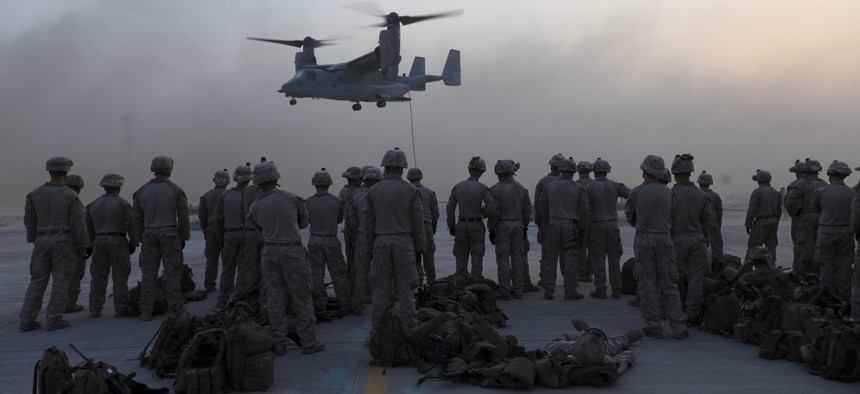
U.S. Marines with the Special Purpose Marine Air Ground Task Force—Crisis Response—Central Command, observe MV-22 Osprey fast rope training in Southwest Asia, Sept. 16, 2015. U.S. Marine Corps Photo by Cpl. Leah Agler
Budget Deal Is A Big Win for Pentagon
Even though it’s only a two-year agreement, the budget deal passed by Congress and the White House will get the Pentagon past the worst of the spending caps.
The Pentagon has weathered the worst of the defense spending caps that military leaders have called a thorn in their side since 2013.
The bipartisan budget deal struck by Congress — the Senate passed the measure early Friday morning, matching the House’s action earlier this week — gives the Defense Department big-time relief immediately, raising the 2016 spending cap by $33 billion and the 2017 cap by $23 billion. That allows the Pentagon to get a total of $607 billion in 2016 and $610 billion in 2017, according to budget experts and investment analysts.
“This is significant. This is a turnaround for defense,” said Todd Harrison, a budget analyst with the Center for Strategic and International studies. “This would mark the end of the drawdown.”
While the budget agreement provides $5 billion less than President Obama requested for 2016, it’s a 5 percent increase over the Pentagon’s 2015 budget, Harrison said.
The spending increases apply to the base budget and the war budget — the latter called the overseas contingency operations fund, or OCO.
In a statement, President Obama said the legislation “will keep us safe by investing in our national security.”
Military personnel accounts, the money for troops pay and benefits, and money for the war in Afghanistan, Iraq, and Syria have been continuously protected since the caps were enacted through the Budget Control Act of 2011. Instead, cuts have come to training, which Pentagon officials have said he reduced the military’s readiness to respond to a crisis. Investments in new weapons and research spending have also been affected.
See also: A Pleasant Surprise for the Defense Budget
The cap increases could help those procurement accounts, said Roman Schweizer, an aerospace and defense policy analyst at Guggenheim Securities.
“The increase for [fiscal 2016] means investment spending ([research and development] and procurement) could be up significantly [year over year] depending on how appropriators complete the conference on the House-Senate bills,” he wrote earlier this week.
That’s welcomed news for defense firms looking for Pentagon business.
“This measure will go a long way in ensuring that we fulfill our commitments to our troops and their families,” said a statement from the National Defense Industrial Association, a defense-industry lobbying arm. “This provides a real opportunity for the Department of Defense to move forward with much needed investments in modernization, readiness, and technology.”
In his own statement, David Melcher, president and CEO of the Aerospace Industries Association, said, “These are significant increases providing badly-needed funds and some measure of stability to the Department of Defense for the next two years.”
Mackenzie Eaglen, a military analyst with the American Enterprise Institute, said the new agreement is better than the “Band-Aid” deal struck two years ago by Sen. Patty Murray, D-Wash., and Rep. Paul Ryan, R-Wisc.
“The newly negotiated budget deal for the next two years is very good news, particularly for the U.S. military and Pentagon planners,” she said. “The defense budget will be funded close to the President’s request this year, there is no threat of a havoc-wreaking long-term continuing resolution, and there is predictability in funding levels for next year.”
But the plus-ups now, mean there is likely to be another budget fight in two years when the original caps return, Harrison said. If and when that happens in fiscal 2018, the Pentagon budget would remain flat or decline slightly.




